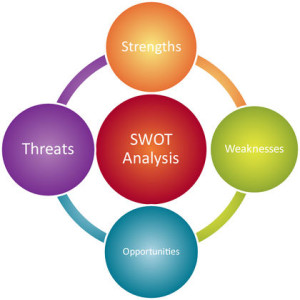If you’ve been attending and exhibiting at tradeshows over the years, no doubt you’ve had many chances to examine what went right and what didn’t. What brought in leads and what didn’t. What opportunities were open and those that weren’t?

But unless you’ve been trained in marketing, or spent a lot time reading about marketing and the analysis of it, you may not have ever done a SWOT analysis.
What’s A SWOT analysis? The SWOT stands for Strengths, Weaknesses, Opportunities and Threats.
A through SWOT analysis will look at internal and external factors, but even a short examination of those areas will likely gather information that you’ll find useful. For your next tradeshow, ask yourself a few questions about each area.
What are your strengths? Do you have a solid brand? Are your products received well? Does your tradeshow booth show off your brand accurately?
Weaknesses: do you have staff members that may not be the right person to represent the company on the show floor? Are your competitors showing up year after year at the show with larger booths trying to squeeze you out?
Opportunities: What areas of new business or new areas can tradeshows assist with? Do you see certain competitors downsizing or vanishing completely from the show floor? Do you find that your products are getting better reviews or responses from potential users?
Threats: Higher labor costs to set up the show. Higher shipping costs. A competitor that is launching a new competing product right across the aisle from you – and yours is still at least a year away.
Take a notepad, draw a line across the middle from top to bottom, and one from left to right and label them: Strengths, Weaknesses, Opportunities, Weaknesses. Start writing down things that come to you. Go over it with your team and management to see if they can identify more for each area.
Some pieces that might fall in any of the quadrants include global markets, new products and services, the cost of money, reduced labor costs, higher exhibit costs, rising costs of raw materials or labor, government regulations, tax changes, etc.
Such an exercise can bring to light a number of things that you might not have been aware of as you prepare for another chaotic appearance at the next big show. And it might not even prompt any immediate changes. But hey, if you think about all of the various items that you wrote down and let it marinate while working the show booth and walking the floor, you will probably find yourself in a position of more understanding of the process, your competitors and how much you can control the outcome of each show. By adding to your knowledge of your own company’s business, the broader business environment, your competitors and other internal and external factors, you will be much more prepared for each coming new show.


Kshitij Thakur ,
The points you mentioned are worth considering before going for a trade show as these will give the company a direction. Trade shows are an important platform for marketing and any marketing effort needs to be analyzed and evaluated.
These trade shows could also be a good indicator towards ascertaining the progress or direction of your close competitors, and also the response of your customer segment.
Kshitij Thakur,
Industry Exhibition Events